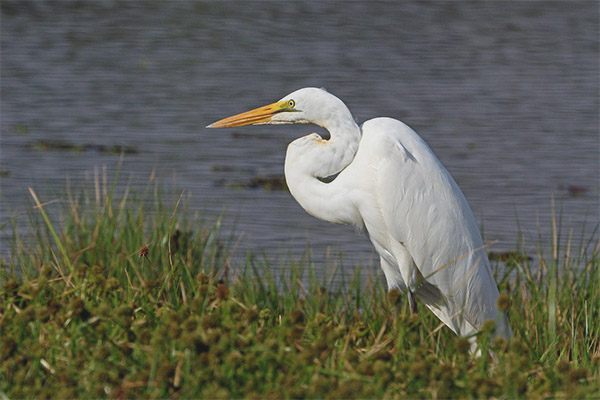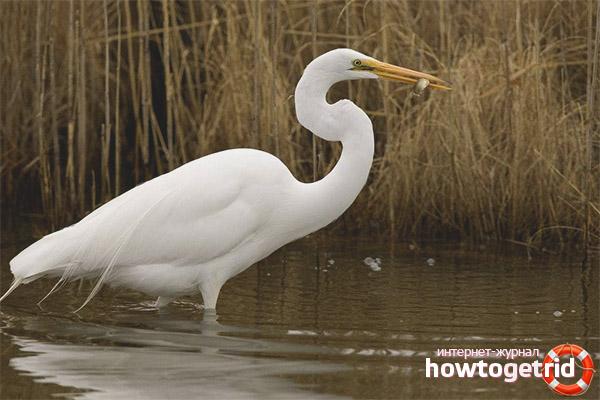The content of the article
A heron is a large bird that immediately attracts attention. Representatives of the tsaplevidny family are similar to storks, but apart from external data nothing binds them. The closest relatives of the family under discussion are considered to be bitterns and croaks. Today we will examine everything related to herons, and also highlight the main aspects in more detail.
Habitat
Individuals of this breed group like warm climatic regions close to tropical ones. They can be found in Eurasia, America, Canada, New Zealand, Australia, Africa, South America.
It can inhabit both brackish and fresh water sources. Prefers medium with moderate or slow flow or without it at all. Species can be found on the marshland, sea shores, as well as rivers.
Most birds attract other sources, for example, river mouths,lowlands like marshes, shores, freshwater or brackish lakes, overgrown in the tropics, flooded farmland, and rice paddies and ditches.
Practically all their life these birds live in the water space. However, when the challenge arises - to get food, they can move to dry places or go from the deep water aground. Individuals feed on small fish, as well as worms and bugs that live within sight.
Description
- The heron, which stands out from the rest of the birds, attracts attention to itself, it is difficult to confuse it with other representatives of birds. In height, these inhabitants grow to 100 cm and more. If you add on to the wingspan of 1.5 meters, you can form your opinion. Grown females and males reach 1 kg in weight, usually males are slightly larger.
- This bird has distinctive features, it is worth highlighting the elongated fingers of gray, as well as the arched neck. Feathers whitish, gray or yellowness is absent. The paws are dark gray or brown, the beak is long, hard and yellow.
- Since the heron is definitely arranged vertebral apparatus, the bird can easily retract the neck and pull it up a decent distance.In the process of obtaining food the bird often uses it.
- The tail is wedge-shaped and shortened, it is practically invisible. When winter comes, white feathers appear in the zone behind the tail and on the sides.
- At the onset of the mating season, the birds lose weight, their dimensions become smaller. The shade of the beak changes from yellowish to orange with red. The heron does not have this species of tuft on its head, unlike its relatives. If you study individuals of the male and female, then visually they are almost no different.
Nutrition
- Since the birds of the represented family belong to predators, the most part of their daily feeding is protein food. That is, herons eat animal food that aground, near the coast, in swampy terrain. Due to its structure, birds can turn their heads and do it quickly. They feel when the game comes, and then they catch it off guard.
- The basis of the daily menu includes crickets, frogs, butterflies, bedbugs and cockroaches (river), snake-like creatures. The bird also eats sea plankton, grasshoppers, crustaceans, small fish, rodents and their offspring.
- Generally speaking, the represented family feeds on all living creatures that cannot stand up for themselves and are in sight. Since there are excellently developed hunting instincts, the heron eats live food.
- By their nature, these individuals do not differ in selectivity. According to experts who explore the lifestyle and behavior of the bird family being discussed, the heron stands on one leg to catch more prey. Because when it moves, “food” literally flows away from under its feet.
Characteristics of the species
- In heron you can notice a kind of grace and smoothness absolutely in all movements. Often the birds go out in search of food in the evening or in the afternoon. Hunting of individuals often occurs in small groups. Often individuals and alone are looking for food.
- The daily routine of such birds is quite familiar. At night, they rest, and during the day go about their business. It is worth noting that herons have a rather aggressive and pugnacious temperament. Often clashes between individuals occur because of tidbits.
- Herons offend those who are smaller in size, but they do not interfere with engaging in a fearless battle with equal relatives.Such individuals often fight for food, despite the fact that there is enough of everything in the marshland. As a result, the one who is stronger wins.
- Even during the flight of herons there is grace. The speed can reach up to 50 km / h. Such indicators are directly dependent on the physical condition of the individual and age. If a heron cannot find food in a familiar area, it flies off to a search for a distance of 15-20 km from a familiar place.
- As soon as the mating season sets in, each bird begins to aggressively defend its territory. Presented herons do not belong to Monogamous. Individuals change partners every season. Some families of birds can freely live in the same area all year.
- Other colonies with the onset of the cold season move to other regions with warmer weather. There are also those individuals that adhere to flights to hot countries. Moreover, the distance of flights are quite large.
- Most of the factors directly depend on the climate and habitat of the herons in question. Also, the population of individuals in a particular place depends on the age of the birds and their physical condition.But, as a rule, most individuals leave their habitat for a short distance. They try to stick to the limits of their usual territory.
Captivity
- It is worth noting that the individuals in question are capable of getting used to different habitats without any problems. Egrets do not show capriciousness in their environment and nutrition. The main rule is that birds should always have free access to the reservoir.
- In addition, these individuals need a large amount of animal feed. Herons should get enough protein per day. Such birds are often kept in large zoos. Presented herons without any problems get used to the conditions of life in captivity. They practically do not get sick and live for a very long time.
- If you are going to keep such birds in captivity, they must provide high-quality and abundant food. In addition, birds should be pampered with various vitamin supplements. It is highly recommended to keep herons in small families. Individuals alone do not live long.
Egrets are unique in nature. Such individuals are distinguished by grace in all movements. Birds have a rather interesting and at the same time aggressive temperament. They will constantly clash with their relatives for food or territory. If you are going to keep herons in captivity, this should be seriously prepare.
Video: Great White Egret (Ardea alba)













To send